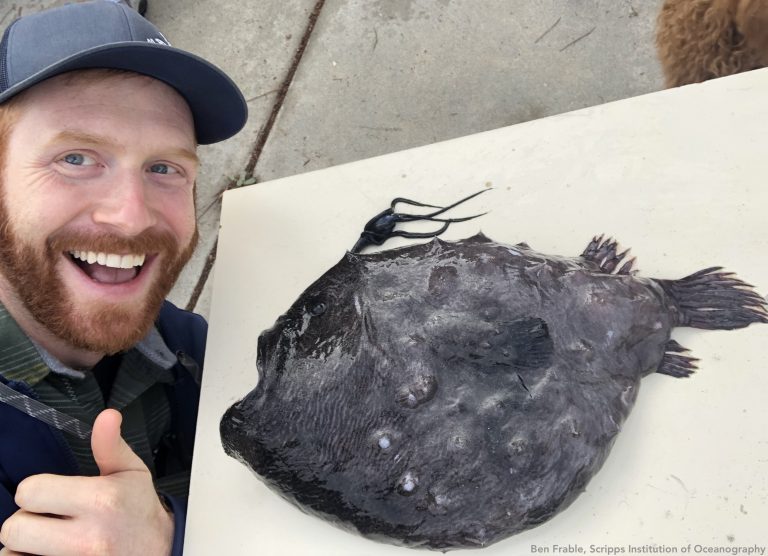Remember the scene in Finding Nemo (2003), where Marlin and Dory are on their adventure to find Nemo? Lost in the deepest and darkest region of the ocean, they are relieved to see a ball of light that they think they can depend on, only to find that the glowing light is attached to a very scary-looking fish. Even the movie-goers were startled by the huge fish with terrifying long fangs.
Last December, a surfer in Swami’s beach, Encinitas, California found a similar-looking fish dead on the beach. Initially, the surfer thought the black blob was a ball of tar. Upon looking at its frightening features, it became evident that this was something unique.
Instead of just ignoring the scary-looking fish, the surfer did the right thing – he handed it to the lifeguard present, who then passed it on to oceanographic scientists to examine it further. Ben Frable, an Ichthyologist from Scripps Institution of Oceanography, UC San Diego was delighted that this rare deep-sea swimmer was received in perfect condition since there was no evidence of physical trauma or poisons, common in specimens found in oil spills.
They swiftly identified it as a Pacific Football Fish, one of the largest of over 100 species of anglerfish around the world. This creature is found at depths of 650 to 2,600 feet below the surface of the water, where no sunlight can penetrate.

The blackfish has a spherical body with spiky flesh. They also have long and terrifying needle-looking teeth that are pointed inward; not for chewing, but to trap their food like fish, crustaceans, and squid. The most notable feature of the fish is the odd alien-like appendage sprouting from its head. It is called the illicium. At the end of it hangs esca, the flashing phosphorescent bulb that lures prey in the pitch dark. These are the moments we can pause a second to think how nature has provided this fish a torchlight attached to its body to find and attract food in the darkest part of the sea.
Success
You are now signed up for our newsletter
Success
Check your email to complete sign up
As part of his study, Dr. Frable took X-rays and obtained tissue samples from the fish for genetic analysis. He also sampled the stomach contents, which could provide data on deep-sea food webs; but found only sand in the belly. This was no surprise since the majority of the football fish recovered on the shore are found with empty stomachs. It’s uncertain whether this has something to do with their demise or whether they don’t consume regularly. After all, they are basically drifting about in a huge dark desert.

This fish was discovered to be a mature female, weighing 5.5 pounds and spanning about 13 inches. Females are substantially larger than males since Anglerfish exhibit sexual dimorphism (where sexes exhibit different traits).
Male Anglerfish develop into sexual parasites that fuse themselves to their partners, sacrificing all of their internal organs, including their eyeballs. The male keeps just his testes, which he uses to deliver sperm in return for sustenance. Despite the terrifying features and descriptions, Dr. Frable still claimed she is a beautiful fish.
Dr. Frable is preserving this Pacific Footballfish to be studied by future scientists because little is known about this odd fish, such as what it eats or how it reproduces. Only 31 specimens have been discovered globally and none have been sighted in the wild. As a result, finding such specimens is seen as a once-in-a-lifetime opportunity to learn something new.

However, this is not the first time this species of Anglerfish washed ashore. The number of Anglerfish turning up on California beaches has risen in the past years, with three sightings of this deep-sea critter last year.
Scripps mentioned that even the experts don’t have enough information to speculate on why numerous deep-sea fish have suddenly washed up onshore. Nevertheless, the scientists are curious to learn more about the samples that have been captured, as well as any new ones that may wash up in the future. The ever-curious Dr. Frable further said, “The fact that a few washed up this year might just be serendipity for us.”
“There’s a lot we don’t know about this species in general,” he said in the Guardian. “It is exactly the type of thing we want to display so people can see it and learn about the world around them and about the strange creatures that are in their own backyard.”
It is actually remarkable that Pixar was able to include this Pacific Footballfish in the film Finding Nemo with accurate characteristics and features despite the fact its discovery was rare at the time!















